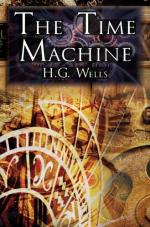|
This section contains 7,250 words (approx. 25 pages at 300 words per page) |

|
SOURCE: Hume, Kathryn. “Eat or Be Eaten: H. G. Wells's The Time Machine.” Philological Quarterly 69, no. 2 (spring 1990): 233-51.
In the following essay, Hume investigates the function of oral fantasies and imagery in The Time Machine.
“It is very remarkable that this is so extensively overlooked,” says the Time Traveller, speaking of time as the fourth dimension.1 Similarly remarkable is the way we have overlooked the comprehensive functions of oral fantasies in The Time Machine. They play a fourth dimension to the other three of entropy, devolution, and utopian satire. They ramify, by regular transformations, into those other three; into the social and economic worlds of consumption and exploitation; and into the realm of gender anxieties. They transform the ideological commonplaces from which the text constructs its reality. They create a network of emotional tensions that subliminally unites the three time frames: Victorian England, the Realm of the Sphinx...
|
This section contains 7,250 words (approx. 25 pages at 300 words per page) |

|


